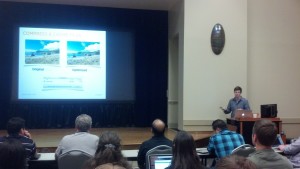by Shay Howe at HTML5 Texas Conference in Austin, TX (Deck)
There are a million ways to write HTML and CSS, and everyone has their own, but is there a right way? Our code needs to be well structured, written in an organized manner, and performance driven. Sharing code with others should be a joyful experience, not absolute terror.
In this session, Shay will cover some best practices and performance tips for writing the highest quality HTML and CSS possible. Writing code is the easy part, finding a practice and structure that works well across the board is the hard part. Shay will outline HTML and CSS conventions that can be applied to your everyday practice.
![Front End Legos - Building Modular CSS]() Common Problems
Common Problems
- Websites have difficulty scaling
- code becomes brittle
- Files and code bases begin to swell
What’s Wrong
Best practices aren’t exactly best practices
- avoid extra elements
- avoid classes
- leverage type selectors
- leverage descendent selectors
We code so specifically (leveraging selectors) that we can’t make the changes we were trying to code for
Specificity?
- Specificity determines which styles are applied
Maintainability
Code must be…
- organized
- modular
- performant
Organization
Approach
- stop thinking about pages
Base
- Core styles for entire site
Normalize (reset), default elements, grid, variables
Components
- User interface concepts & design patterns
Alerts, buttons, forms, lists
Modules
- Business logic
Aside, Header, Footer
Your goal over time should be to not write css and just write HTML and see how the styles are automatically applied.
Looking at rdio site for modularity
Modularity
We put a lot of effort into our properties and values, but not so much on our selectors.
- use a grid
- separate presentation (or theme) from layout
code for reusable elements
Accommodate Content
- remove the container element selectors
- Use selectors instead of elements
Great ideas on using classes to really separate content from layout
Watch Specificity
- be explicit
- keep specificity low
- Never use IDs or !important
- avoid nested selectors (minimize)
measuring Specificity
Formula
count IDs, Classes/Pseudo-classes/attributes, Elements
High Specificity (bad)
Low Specificity (good)
Use Classes
- write understandable class names
- avoid unnecessary nesting
- use same strength specificity
Methodologies
OOCSS
Object-Oriented CSS (Nicole Sullivan – oocss.org)
SMACSS
Scalable and Modular Architecture for CSS (Jonathan Snook – smacss.com)
Reuse Code
- Do not duplicate code
- remove old code
- defer loading subsequent styles
Minimize Requests
- combine lide files
- use image sprites (use caution)
- use data URIs (difficult to edit)
Compress & Cache Files
- utilize gzip compression
- losslessly compress images
- cache common files
HTML5 Boilerplate includes compression and caching
Getting Started
- Build a styleguide (Twitter Bootstrap, Zurb Foundation)
- Review Methodologies (OOCSS, SMACSS)
- Test your code (CSS Lint, Inspector, PageSpeed)
Related articles
What people are looking for when they find this page: Jonathan Jeter, oocss, oocss tipps, performance google chrome -youtube -networking, smacss



